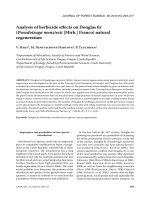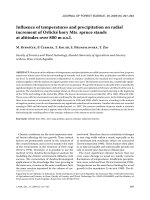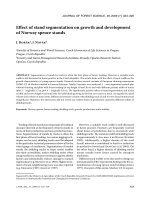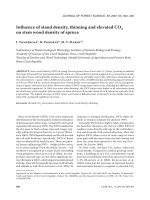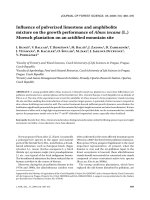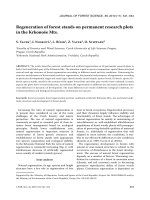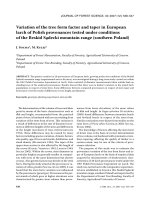Báo cáo lâm nghiệp:"Influence of cotyledon removal on early seedling growth in Quercus robur L." doc
Bạn đang xem bản rút gọn của tài liệu. Xem và tải ngay bản đầy đủ của tài liệu tại đây (470.43 KB, 5 trang )
69
Ann. For. Sci. 60 (2003) 69–73
© INRA, EDP Sciences, 2003
DOI: 10.1051/forest: 2002075
Original article
Influence of cotyledon removal on early seedling growth
in Quercus robur L.
Francisco García-Cebrián, Jordán Esteso-Martínez and Eustaquio Gil-Pelegrín*
Unidad de Recursos Forestales, Servicio de Investigación Agroalimentaria, Gobierno de Aragón, Apdo, 727, 50.080 Zaragoza, Spain
(Received 2 July 2001; accepted 7 February 2002)
Abstract – The process of resource transfer from seed to growing plant, in terms of dry matter and nitrogen, was studied in Quercus robur L.
seedlings. In a factorial experiment, seedlings were subjected to cotyledon excision and shading just after shoot emergence. In another
experiment, we removed the cotyledons at emergence and 7, 14 and 21 days later. The transfer of resources from cotyledons to growing plant
seemed to be almost complete at a very early stage. Cotyledon excision just after shoot emergence resulted in a significant reduction in seedling
growth. Shading had a minor effect during this period. However, the influence of cotyledons on seedling growth declines soon. Their artificial
suppression had no significant effect when it was performed later than two weeks after shoot emergence. The consequences of this fact on the
relationship between dispersion by jays and seedling growth are discussed.
Quercus robur L. / reserve effect / cotyledon / nitrogen transfer
Résumé – Influence de l’excision des cotylédons sur la croissance initiale des semis de Quercus robur L. On a étudié le mécanisme de
transfert des réserves de glands de Quercus robur L. vers le semis, évalué par le poids sec et la teneur en azote. Dans une expérimentation
factorielle, après la germination, les cotylédons ont été enlevés et les semis placés sous ombrage. Dans une deuxième expérimentation, les
cotylédons ont été supprimés à différentes périodes : à la germination, 7, 14 et 21 jours après. Le transfert des réserves des cotylédons vers le
semis semble être terminé très tôt. L’excision des cotylédons juste après la germination réduit significativement la croissance initiale des semis ;
par contre, l’effet de l’ombrage durant cette période est plus faible. Néanmoins, l’influence des cotylédons sur la croissance des semis diminue
très tôt. Sa suppression artificielle n’a pas d’effet significatif au-delà de deux semaines après la germination. Les conséquences de ce fait sur la
relation entre les geais, principaux disperseurs des glands, et les chênes sont discutées.
Quercus robur L. / effet de réserve / cotylédon / transfert d’azote
1. INTRODUCTION
Oaks can be considered as typical of large seeded tree spe-
cies in the northern hemisphere [14]. This reproductive strat-
egy of higher plants, which implies a high effort in the con-
struction of each single seed [9], has received different
functional interpretations. On one hand, it has been suggested
that large seeds could be more attractive to dispersal agents,
resulting in a wider dispersion [1, 6, 24, 28].
On the other hand, it is widely accepted that big seeds can
offer a large amount of metabolic reserves to the growing
seedlings [31]. This may improve the early development of the
growing plant [16] and increase its chances of survival. Such
amounts of metabolizable compounds may allow the develop-
ment of vigorous root systems able to explore large volumes
of soil in nutrient poor sites [2, 7, 10, 25, 30] or to reach deep
soil horizons with larger moisture availability [3, 4, 15, 22].
Seed reserves would also allow the seedling to overcome tem-
poral deficits in carbohydrate synthesis under low light condi-
tions [13, 17, 29]. This positive effect of seed size on seedling
growth affects not only final seedling size, but also its growth
rate as shown in Merouani et al. [20]. These authors confirmed
that seedlings of Quercus suber originating from the largest
seeds had also the fastest growth rate.
The main objective of this paper was to deepen the knowl-
edge of the role of large seeds in early seedling growth in
Quercus. We wanted to define the term at which the plant does
no longer depend on seed resources, as well as the importance
of these resources under low light conditions as a stressing fac-
tor. With this aim, we first described the kinetic of resources
transfer in terms of bulk biomass and nitrogen from the coty-
ledons to the seedling. Secondly, we analyzed the extent of the
functional dependence between seedling growth and seed
reserves by artificial suppression of cotyledon and by shading
at different growth stages.
* Correspondence and reprints
Tel.: 34 976 716373; fax: 34 976 716335; e-mail:
70 F. García-Cebrián et al.
2. MATERIALS AND METHODS
Acorns were collected from a selected pure stand of Quercus
robur at an elevation of 230 meters a.s.l. in Caldas de Reis (Ponteve-
dra) in north western Spain during Autumn 1995. Procedures for
acorn selection and storage followed the common recommendations
for recalcitrant seeds [8, 12, 19].
A total number of 546 seeds were sown on May 1996 and 376
seedlings were obtained. The fresh weight of each single acorn was
recorded up to the first 0.1 g just prior to sowing. The ratio between
seed fresh weight – pericarp included – and embryo dry weight – peri-
carp excluded – was established by linear regression in 60 acorns rep-
resenting all the size variation found in the sample. The mean fresh
weight of the seeds was 4.8 g (SD = 1.5).
Cylindrical pots, 300 mm in length and 70 mm of inner diameter,
were used in order to adjust the container shape to the morphology of
the root system of oak seedlings. Containers were filled with nutrient
free sand. Nutrient supply was ensured by using a slow-liberation fer-
tiliser as described by Naidu and DeLucia [23]. Plants were watered
three times per week.
The experiments were performed in a greenhouse equipped with
partial climatic control. Temperature and air relative humidity were
recorded with a thermohygrograph (JRI MINIDISQUE 165-00, Jules
Richard Instrument, Argenteuil, France). Mean air temperature was
21.8 (s.d. 3) and mean relative humidity was 85.2 (s.d. 8.6) through
the experiment. A white shade screen was extended on the exterior of
the greenhouse to tone down light intensity. The average maximum
light level measured in the interior of the greenhouse was
760 mmol m
–2
s
–1
. The measurements were carried out at midday
with a PAR-sensor (ELE-International System, Hertfordshire, UK)
during five cloudless days. The heliograph of a meteorological station
close to the greenhouse pointed out that only 4.6% of the days were
cloudy during the summer of 1996, which made the light regime to be
very regular through the plant growth period.
One of the aims of the present study was to analyse the evolution
of early plant growth with respect to the consumption of seed
reserves. Thus, the kinetic of changes in dry weight and in nitrogen
content of both the cotyledons and the growing plant, was established
prior to the analysis of the effect of cotyledon removal. To achieve
this, a schedule of destructive harvests through seedling development
was defined [7]. The harvesting schedule started just after full epi-
cotyl development, when the shoot had reached a length of 5–7 cm
and the leaves were not expanded yet (hereafter “shoot emergence”).
The start time for harvests was defined for each single plant, depend-
ing on the date of emergence.
Another objective of this study was to analyse the combined effect
of cotyledon removal and shading. The cotyledons of half of the seed-
lings were removed at emergence. Removed cotyledons were
labelled and dried at 80 ºC during 48 hours. After this, the whole sam-
ple (with and without cotyledons) was divided and set into two differ-
ent light conditions. Half of the sample was grown under full light
conditions and the other half under a black screen which intercepted
90% of the incoming light. Four treatments resulted, namely full
light/no excision (FL/NE), full light/excision (FL/E), shade/no exci-
sion (S/NE) and shade/excision (S/E). Plants from each treatment
were also divided into three subsamples that were harvested at shoot
emergence, 14 and 28 days after.
Finally, the effect of cotyledon removal on seedling growth was
tested at different stages of plant development. Cotyledon excision
was made at shoot emergence in one set of plants and 7, 14 and 21
days after shoot emergence in three other sets of seedlings. Addi-
tional destructive harvests were also made simultaneously to record
the dry weight of the plants at the time of excision. Seedlings were
harvested 21 days after cotyledon removal. As a control, sets of
unmanipulated plants were harvested in equal times.
In all cases, after harvesting, the whole plant was removed from
the containers and the roots and shoots were washed with water until
sand particles were completely eliminated. Clean plants were sepa-
rated into cotyledons, pericarp, root, stem and leaves. These organs
and the removed cotyledons were dried at 80 ºC for 48 h and
weighted. Total nitrogen content was determined as an additional
measure for each single sample by using the Kjeldahl method.
The number of individual seedlings used during each experiment
and treatment are shown in table I. The effect of the experimental
treatments and the possible interaction between factors were analysed
by a two–way analysis of variance for each treatment combination
and development stage with SAS Proc GLM (SAS Institute Inc.,
1988) [26]. The effect of cotyledon removal on the average dry
weight of plants at different developmental stages in experiment two
was tested by a t-test.
3. RESULTS
Figure 1 shows the weekly time-course of dry matter and
nitrogen content of cotyledons and growing seedlings under
optimal irradiance and nutritional conditions. Sigmoidal mod-
els could be fitted to the data as described by Brookes et al. [7].
Both cotyledon dry matter and N content decreased down to an
asymptotic threshold that was reached 3 and 4 weeks after
shoot emergence respectively. A fraction of the cotyledon
Table I. Number of replications in each experiment, stage of growth and experimental conditions.
Factorial experiment Harvest at
different stages
of growth
Full light Shade
Stage of growth Control Cotyledon removal Control Cotyledon removal Control Cotyledon removal
Emergence 40 – – – 40 –
7 days – – – – 15 –
14 days 31 22 28 28 31 –
21 days – – – – 14 –
28 days 36 23 32 10 36 23
35 days – – – – 18 15
42 days – – – – 16 16
49 days – – – – 15 17
Cotyledon removal in Quercus robur seedlings 71
biomass (31.2%) and nitrogen content (27.2%) was not there-
fore transferred to the growing plant. Similarly, seedling dry
matter and nitrogen content increased and reached a plateau
until the beginning of the second growth flush that began 35
days after emergence.
Cotyledon removal at emergence and shade had significant
effects on seedling biomass reached 2 or 4 weeks after emer-
gence (figure 2 and table II). Shade induced a significant
reduction of growth that was already visible 2 weeks after
emergence, and increased during the third one (approx. 1.3
times more biomass in the light). The impact of cotyledon
severing was nevertheless much larger, resulting in a biomass
reduction by approximately a factor 3 as compared to the
respective controls. Interestingly, cotyledon removal reduced
growth to a larger extent in the light than under shade.
The time course of the impact of cotyledon severing after
increasing time lags following emergence are shown in
figure 3. The impact of severing was significant at emergence
and one week later, but had no effect when practised 2 or 3
weeks after emergence.
Figure 1. Time course of dry weight and total nitrogen content in cotyledons and seedlings of Q. robur, mean ± S.E. A sigmoid model was fit
to the data. The model has been graphically extended in C and D for a better comprehension (dotted part of line).
Figure 2. Dry weight of Q. robur seedlings
2 or 4 weeks after emergence, as a function
of irradiance (FL: full light; S: shade) and
of cotyledon severing at shoot emergence
(NE: no excision; E: excision). Means ± S.E.
72 F. García-Cebrián et al.
4. DISCUSSION
The results of this study should help to understand the role
of seed reserves on early seedling growth in Quercus species.
The availability of an extra amount of metabolic resources
stored in the large cotyledons is considered to increase the
chances for the young plant to establish successfully in the for-
est understory. Lord et al. [18] concluded that the abundance
of large seeds in tropical floras could be explained by the
higher metabolic costs for converting seed reserves into seed-
lings under elevated temperatures. The sharp reduction on
consecutive plant growth observed when cotyledons were
removed at emergence, both under high light conditions as
under deep shading, corroborates this last idea. Reduction on
seedling growth as a consequence of early cotyledon extirpa-
tion has been also demonstrated by Frost and Rydin [11], Mil-
berg and Lamont [21] and Bonfil [5].
However the “reserve effect”, as defined by Saverimuttu
and Westoby [27], declines rapidly during seedling develop-
ment. The early decline of resource transfer rate from seed
results in the reduction of the effect of extirpation as the seed-
ling grows. In fact, according to our results, the extent of the
transfer reaches 80% of the biomass and 73% of the nitrogen
content respectively only 14 days after shoot emergence.
Some authors have reported that cotyledon extirpation had
no effect on growth in oaks [1, 15, 28]. Our results support this
finding but only when excision is practised 14 or 21 days after
shoot emergence. Although we are unable to compare exactly
the time of removal between these studies and ours, we sus-
pect that extirpation must have been done later than the critical
moment detected by us (around fourteen days after s.e.).
The role of seed predators is potentially large during the
early seedling life. As pointed out by Sonesson [28], Garrulus
glandarius L. has a key role in oak stands regeneration,
searching, transporting and hoarding acorns during autumn.
However, when seedlings emerge in spring, jays remove the
edible cotyledons and feed their fledglings with them. In this
way, jays may reduce the viability of oak seedlings if cotyle-
dons were removed at a very early moment (i.e., before 14th
day since emergence). Afterwards, predation would have no or
only a little effect if resource transfer had almost concluded.
Acknowledgements: We are most grateful to Dr. Kerstin Sones-
son and two anonymous reviewers for the useful comments about a
preliminary draft of this paper. This study has been supported by the
“Comisión Interministerial de Ciencia y Tecnología” project AGF96-
0399, Spain.
REFERENCES
[1] Andersson C., Frost I., Growth of Quercus robur seedlings after
experimental grazing and cotyledon removal, Acta Bot. Neerl. 45
(1996) 85–94.
[2] Allsopp N., Stock W.D., Relationships between seed reserves,
seedling growth and mycorrhizal responses in 14 related shrubs
(Rosidae) from a low-nutrient environment, Funct. Ecol. 9 (1995)
248–254.
Table II. F statistics and significance levels for MANOVA. See text
for details.
Growth stage
(days)
Source of
variation
df F value Sig. Level
14
Light 1 4.36 0.0392
Cotyledon severing 1 181.287 0
Light ´ Severing 1 4.455 0.0372
Error 106
28
Light 1 5.69 0.019
Cotyledon severing 1 95.32 0.0001
Light ´ Severing 1 1.95 0.1658
Error 99
Figure 3. Seedling dry weight measured
three weeks after cotyledon severing as a
function of the delay between emergence
and severing (0, 1, 2, 3 weeks after emer-
gence). Means ± S.E. Different letter indi-
cates significant differences (P >0.05)
between treatments for each severing time.
Cotyledon removal in Quercus robur seedlings 73
[3] Bacilieri R., Bouchet M.A., Bran D., Grandjanny M., Maistre M.,
Perret P., Romane F., Germination and regeneration mechanisms in
Mediterranean degenerate forests, J. Veget. Sci. 4 (1993) 241–246.
[4] Baker H.G., Seed weight in relation to environmental conditions in
California, Ecology 53 (1972) 997–1010.
[5] Bonfil C., The effects of seed size, cotyledon reserves and
herbivory on seedling survival and growth in Quercus rugosa and
Q. laurina (Fagaceae), Am. J. Bot. 85 (1998) 79–87.
[6] Bossema I., Jays and oaks: an eco-ethological study of a symbiosis,
Behaviour 70 (1979) 1–117.
[7] Brookes P.C., Wigston D.L., Bourne W.F., The dependence of
Quercus robur and Quercus petraea seedlings on cotyledon
potassium, magnesium, calcium and phosphorus during the first
year of growth, Forestry 53 (1980) 168–177.
[8] Catalán-Bachiller G., Semillas de árboles y arbustos forestales,
Colección Técnica ICONA-MAPA, 1991.
[9] Farmer R.E. Jr., Seed ecophysiology of temperate and boreal zone
forest trees, St. Lucie Press, Delray Beach, Florida, 1997.
[10] Foster S.A., On the adaptive value of large seeds for tropical moist
forest trees: a review and synthesis, Bot. Rev. 52 (1986) 260–299.
[11] Frost I., Rydin H., Effects of competition, grazing and cotyledon
nutrient supply on growth of Quercus robur seedlings, Oikos 79
(1997) 53–58.
[12] Gribko L.S., Jones W.E., Test of the float method of assessing
northern Red Oak acorn condition, Tree Plant. Notes 46 (1995)
143–147.
[13] Grime J.P., Jeffrey D.W., Seedling establishment in vertical
gradients of sunlight, J. Ecology 53 (1965) 621–642.
[14] Harper J.L., Lovell P.H., Moore K.G., The shapes and sizes of
seeds, An. Rev. Ecol. System. 1 (1970) 327–356.
[15] Jarvis P.G., The effects of acorn size and provenance on the growth
of seedlings of sessile oak, Q. J. For. 57 (1963) 11–19.
[16] Jurado E., Westoby M., Seedling growth in relation to seed size
among species of arid Australia, J. Ecol. 80 (1992) 407–416.
[17] Leishman M.R., Westoby M., The role of large seed size in shaded
conditions: experimental evidence, Funct. Ecol. 8 (1994) 205–214.
[18] Lord J., Egan J., Clifford T., Jurado E., Leishman M., Williams D.,
Westoby M., Larger seeds in tropical floras: consistent patterns
independent of growth form and dispersal mode, J. Biogeogr. 24
(1997) 205–211.
[19] Merouani H., Branco C., Almeida M.H., Pereira J.S., Compor-
tement physiologique des glands de chêne liège (Quercus suber L.)
durant leur conservation et variabilité inter-individus producteurs,
Ann. For. Sci. 58 (2001) 143–153.
[20] Merouani H., Branco C., Almeida M.H., Pereira J.S., Effects of
acorn storage duration and parental tree on emergence and
physiological status of Cork oak (Quercus suber L.) seedlings,
Ann. For. Sci. 58 (2001) 543–554.
[21] Milberg P., Lamont B.B., Seed/cotyledon size and nutrient content
play a major role in early performance of species on nutrient-poor
soils, New Phytol. 137 (1997) 665–672.
[22] Mosandl R., Kleinert A., Development of oaks (Quercus petraea
(Matt.) Liebl.) emerged from bird-dispersed seeds under old-
growth pine (Pinus silvestris L.) stands, For. Ecol. Manage. 106
(1998) 35–44.
[23] Naidu S.L., DeLucia E.H., Growth, allocation and water relations
of shade-grown Quercus rubra L. samplings exposed to a late-
season canopy gap, Ann. Bot. 80 (1997) 335–344.
[24] Oakwood M., Jurado E., Leishman M., Westoby M., Geographic
ranges of plant species in relation to dispersal morphology, growth
form and diaspore weight, J. Biogeogr. 20 (1993) 563–572.
[25] Ovington J.D., MacRae C., The growth of seedlings of Quercus
petraea, J. Ecol. 48 (1960) 549–555.
[26] SAS / STAT TM, Guide for personal computers, Version 6 ed.,
Carg. NC, SAS Institute Inc., 1998.
[27] Saverimuttu T., Westoby M., Seedling longevity under deep shade
in relation to seed size, J. Ecol. 84 (1996) 681–689.
[28] Sonesson L.K., Growth and survival after cotyledon removal in
Quercus robur seedlings, grown in different natural soil types,
Oikos 69 (1994) 65–70.
[29] Tripathi R.S., Khan M.L., Effects of seed weight and microsite
characteristics on germination and seedling fitness in two species of
Quercus in a subtropical wet hill forest, Oikos 57 (1990) 289–296.
[30] Venable D.L., Size-number trade-offs and the variation of seed size
with plant resource status, Am. Nat. 140 (1992) 287–304.
[31] Westoby M., Jurado E., Leishman M., Comparative evolutionary
ecology of seed size, Tree 7 (1992) 368–372.
To access this journal online:
www.edpsciences.org
